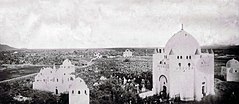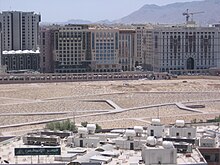Demolition of al-Baqi
24°28′02″N 39°36′58″E / 24.4672°N 39.616°E
 Jannat al-Baqi before demolition | |
| Date | 1806 and 1925 (or 1926) |
|---|---|
| Location | Medina, Saudi Arabia |
| Organised by | Wahhabis of Najd |
| Outcome | Mass destruction of the buildings, and domes of the cemetery |
Al-Baqi cemetery, "the oldest and historically most important Islamic graveyard" located in Medina, Saudi Arabia, has been demolished[1] by forces loyal to the Wahhabi-Saudi alliance in 1806 and 1925[2] (or 1926).[1][3] Wahhabi forces were defeated by Ottoman forces after the first demolition and the buildings of al-Baqi were rebuilt. However, years later, Medina was recaptured by the Wahhabis and al-Baqi was destroyed by them once again.
History of Baqi

Baqi al-Gharqad (Template:Lang-ar, "the field of thorny threes"), also known as Jannat al-Baqi (Template:Lang-ar,"garden of tree stumps"), was used as a cemetery before the advent of Islam. It gained attention after the first companion of the Prophet Muhammad was buried there in 625. Four Shi'a Imams: Hasan ibn Ali, Ali ibn Husayn, Muhammad al-Baqir, and Jafar al-Sadiq were buried there[2] making it an important location for Shia Muslims.[4]
Historical records show that there were domes, cupolas, and mausoleums in Jannat al-Baqi before the 20th century; today it is bare land without any buildings.[2]
Demolitions

First demolition
At the beginning of the Wahhabis of Najd's nineteenth century (1806) control over Mecca and Medina, they demolished many of the religious buildings including tombs and mosques, whether inside or outside the Baqi,[5] in accordance with their doctrine.[1] These were razed to the ground[6][3] and plundered for their decorations and goods.[7]
European traveler Johann Ludwig Burckhardt visited the cemetery in 1815 after the first destruction. Seeing the ruins of the domes around the cemetery, he concluded that people of Medina were "niggardly", paying little attention to honoring "their celebrated countrymen." However, the destruction could not prevent residents from performing their rituals and political power was re-established some years later.[2]
Non-Wahhabi Muslims were prohibited from performing the Hajj pilgrimage at the time. A year before the destruction, Iraqi and Iranian Muslims were not allowed to perform Hajj. Syrians and Egyptians were refused permission to perform Hajj in 1806 and 1807, respectively.[5]
Sultan Mahmud II, Ottoman emperor at the time, ordered the governor of Egypt, Muhammad Ali Pasha, to attack the rebels and Muhammad Ali Pasha's son, Ibrahim Pasha, defeated Najdi clans at the battle of Diriyah. By order of Sultan Mahmud II[3] the Ottomans built and "renovated" buildings, domes, and mosques in "splendid aesthetic style" from 1848 to 1860.[5] Richard Burton, who visited Medina in 1853 disguised as an Afghan Muslim named "Abdullah", said that there were fifty-five mosques and shrines after reconstruction by the Ottomans. The city is described by another English adventurer visiting Medina in 1877–1878 as a "small beautiful city resembling Istanbul." He mentions its "white walls, golden slender minarets and green fields."[6] Also, Ibrahim Rifat Pasha described sixteen domes marking individual and/or a collection of graves.[2]
Second demolition
The Al-Saud clan regained control of Hijaz in 1924[3] (or 1925).[1] The following year King Ibn Saud granted permission to destroy the site with religious authorization provided by Qadi Abd Allah ibn Bulayhid, and the demolition began on 21 April 1926[3] (or 1925)[8][2] by Ikhwan ("The Brothers"), a Wahabbi religious militia.[9] The demolition included destroying "even the simplest of the gravestones".[1] British convert Eldon Rutter compared the demolition to an earthquake: "All over the cemetery nothing was to be seen but little indefinite mounds of earth and stones, pieces of timber, iron bars, blocks of stone, and a broken rubble of cement and bricks, strewn about."[3]
The workers destroying the buildings received 1,000 Majidi Riyal,[10] the unit of currency at the time.[11] Some of the destroyed domes included those of: Abdullah ibn Abdul-Muttalib and Aminah, Muhammad's father and mother, respectively, Isma'il ibn Jafar, Abbas ibn Abd al-Muttalib and Hamza ibn Abdul-Muttalib—both uncles of Muhammad, Ibrahim ibn Muhammad—Muhammad's son, Malik ibn Anas, Uthman ibn Affan, four Shia Imams[10] and 7,000 people who supposedly had ties with the prophet Muhammad.[12]
Motivations
Wahhabis tried to perform the demolition within a legal religious context since they regarded the shrines as "idolatrous" and believed that marking graves is Bid'a (heresy),[13] based on their interpretation of Qur'anic verses regarding graves and shrines.[14] For this, they refer to story of the golden calf found in the Qur'an.[15] Weeks before the second demolition, at the request of Ibn Bulayhid, a group of fifteen scholars from Medina unanimously issued a fatwa condemning the making of mausoleums around the graves.[2]
According to Adeel Mohammadi, the Wahhabis' destruction of al-Baqi also had political roots. The leader of a Muslim community is responsible for performing enjoining good and forbidding wrong (al ʿamr bi-l maʿrūf wa-n nahy ʿan al munkar) and he can fulfill this responsibility only by having political power. The destruction by the Wahhabis' was a political act to establishing Najdi authority in the Hijaz. This consisted of the religious authority of Najd Wahhabi scholars and the political authority of the Saudi family to broadcast their "newly acquired political power", Mohammadi argues.[2]
The veneration of Islamic shrines in the Hijazi cities of Mecca and Medina [...] reflected a desire for unity not only in the theological approach to God but also in the political approach to land [...] Thus iconoclasm represented, for Wahhabism, a means of bridging the principles of theological and political.
- —James Noyes in Politics of Iconoclasm.[2]
Also, according to Mohammadi, the destruction could be done with the purpose of indicating victory over Shia, as al-Baqi is the burial place of a number of Shia Imams and members of Ahl al-Bayt ("People of the House") - Muhammad's family.[2]
Reactions
The second demolition was discussed in Majles-e Shora-ye Melli (The National Consultative Assembly of Iran) and a group of representatives was sent to Hijaz to investigate. In recent years, efforts were made by Iranian religious scholars and political figures to restore the cemetery and its shrines.[3] Both Sunni and Shia protested against the destruction[1][8] and rallies are held annually[16][1][17] in Pakistan,[18] Iran,[19] and the United States.[20][16][21] The day is regarded as Yaum-e Gham ("Day of Sorrow").[8] Prominent Sunni theologians and intellectuals have condemned the "unfit" situation of the al-Baqi cemetery but the Saudi authorities have so far ignored all criticism and rejected any requests for restoration of the tombs and mausoleums.[3]
See also
References
- ^ a b c d e f g Werner, Ende (2010). "Baqīʿ al-Gharqad". In Fleet, Kate (ed.). Encyclopaedia of Islam (Third ed.). Retrieved 28 August 2016.
- ^ a b c d e f g h i j Mohammadi, Adeel (2014–2015). "The destruction of Jannat al-Baqi': A case of Wahhabi Iconoclasm" (PDF). Undergraduate Journal of Middle East Studies (8). Canada: 47–56. Retrieved 30 July 2016.
{{cite journal}}: CS1 maint: date format (link) - ^ a b c d e f g h Bahramian, Ali; Gholami, Rahim (2013). "al-Baqīʿ". In Madelung, Wilfred; Daftary, Farhad (eds.). Encyclopaedia Islamica (Third ed.). Retrieved 2 September 2016.
- ^ Shomali, Mohammad A. Shi'i Islam: Origins, Faith and Practices. ICAS Press. ISBN 9781904063117. Retrieved 4 September 2016.
- ^ a b c Ahmed, Irfan. "The Destruction Of The Holy Sites in Mecca and Medina". Islamica Magazine. No. 15. Archived from the original on 13 July 2011. Retrieved 7 September 2016.
{{cite magazine}}: Cite has empty unknown parameter:|dead-url=(help) - ^ a b "History of the Cemetery Of Jannat Al-Baqi". Al-Islam.org. Retrieved 9 September 2016.
- ^ Bahramian, Ali. "Baqi". The Great Islamic Encyclopedia (in Persian). Retrieved 9 September 2016.
- ^ a b c Shahi, Afshin. The Politics of Truth Management in Saudi Arabia. Routledge. ISBN 9781134653195. Retrieved 14 September 2016.
- ^ "The Destruction Heritage in Saudi Arabia" (PDF). The Center for Academic Shi'a Studies. August 2015. Retrieved 14 September 2016.
- ^ a b Qazi Askar, Ali (2003). "Destruction of Baqi from the viewpoint of the documents". Haj Miqat (45): 115–142. Retrieved 12 September 2016.
- ^ "The Historical Framework of the Currency of Saudi Arabia". sama.gov.sa. Retrieved 12 September 2016.
- ^ Staff writers. "Mapping the Saudi State, Chapter 7: The Destruction of Religious and Cultural Sites" (PDF). American For Democracy & Rights in Bahrain. Retrieved 13 September 2016.
- ^ Curtin Winsor, Jr. "Annaqed – The Critic – Saudi Arabia, Wahhabism and the Spread of Sunni Theofascism". annaqed.com. Retrieved 14 September 2016.
- ^ Illustrated Dictionary of the Muslim World. Marshall Cavendish. ISBN 9780761479291. Retrieved 14 September 2016.
- ^ Beauchamp, Zack (19 August 2015). "Why ISIS is destroying Syrian and Iraqi heritage sites". Vox. Retrieved 15 September 2016.
- ^ a b Hassan, Sara (27 July 2015). "Protests at Saudi Embassy in Washington". American al-Jazeera. Retrieved 7 September 2016.
- ^ in India"Shiites protest demolition of Muslim graveyard in Medina". Times of India. 2011. – via General OneFile (subscription required)
- ^ "راهپیمایی محکومیت سالروز تخریب بقیع در پاکستان".
- ^ "راهپیمایی مردم جیرفت در سالروز تخریب بقیع – نمایش محتوای خبر – صدا و سیمای کرمان".
- ^ "Gathering of Shi'a Muslim in Washington condemning destruction of al-Baqi" (in farsi). Retrieved 12 September 2016.
{{cite web}}: CS1 maint: unrecognized language (link) - ^ Husayn, Rahat (18 November 2014). "Saudi Arabia's confused stance on Shiites results in both praise and executions". Washington Times. Retrieved 13 September 2016.
